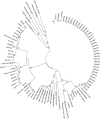Human adenovirus among hospitalized children with respiratory tract infections in Beijing, China, 2017-2018
- PMID: 31196108
- PMCID: PMC6567909
- DOI: 10.1186/s12985-019-1185-x
Human adenovirus among hospitalized children with respiratory tract infections in Beijing, China, 2017-2018
Abstract
Background: Human adenoviruses (HAdVs) cause a wide range of diseases. However, the genotype diversity and epidemiological information relating to HAdVs among hospitalized children with respiratory tract infections (RTIs) is limited. Here, we describe the epidemiology and genotype distribution of HAdVs associated with RTIs in Beijing, China.
Methods: Nasopharyngeal aspirates (NPA) were collected from hospitalized children with RTIs from April 2017 to March 2018. HAdVs were detected by a TaqMan-based quantitative real-time polymerase chain reaction (qPCR) assay, and the hexon gene was used for phylogenetic analysis. Epidemiological data were analyzed using statistical product and service solutions (SPSS) 21.0 software.
Results: HAdV was detected in 72 (5.64%) of the 1276 NPA specimens, with most (86.11%, 62/72) HAdV-positives cases detected among children < 6 years of age. HAdV-B3 (56.06%, 37/66) and HAdV-C2 (19.70%, 13/66) were the most frequent. Of the 72 HAdV-infected cases, 27 (37.50%) were co-infected with other respiratory viruses, most commonly parainfluenza virus (12.50%, 9/72) and rhinovirus (9.72%, 7/72). The log number of viral load ranged from 3.30 to 9.14 copies per mL of NPA, with no significant difference between the HAdV mono- and co-infection groups. The main clinical symptoms in the HAdV-infected patients were fever and cough, and 62 (86.11%, 62/72) were diagnosed with pneumonia. Additionally, HAdVs were detected throughout the year with a higher prevalence in summer.
Conclusions: HAdV prevalence is related to age and season. HAdV-B and HAdV-C circulated simultaneously among the hospitalized children with RTIs in Beijing, and HAdV-B type 3 and HAdV-C type 2 were the most frequent.
Keywords: Epidemiology; Human adenovirus; Respiratory tract infection.
Conflict of interest statement
The authors declare that they have no competing interests.
Figures



References
-
- Mei YF, Skog J, Lindman K, Wadell G. Comparative analysis of the genome organization of human adenovirus 11, a member of the human adenovirus species B, and the commonly used human adenovirus 5 vector, a member of species C. J Gen Virol. 2003;84(8):2061–2071. doi: 10.1099/vir.0.19178-0. - DOI - PubMed
Publication types
MeSH terms
LinkOut - more resources
Full Text Sources
Miscellaneous

